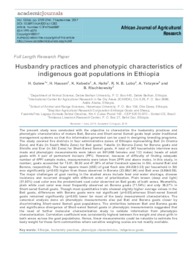Husbandry practices and phenotypic characteristics of indigenous goat populations in Ethiopia.
Husbandry practices and phenotypic characteristics of indigenous goat populations in Ethiopia.
Autoria: GATEW, H.; HASSEN, H.; KEBEDE, K.; HAILE, A.; LOBO, R. N. B.; YETAYEW, A.; RISCHKOWSKY, B.
Resumo: Abstract: The present study was conducted with the objective to characterize the husbandry practices and phenotypic characteristics of mature Bati, Borana and Short-eared Somali goats kept under traditional management systems so that the information generated can be used in designing breeding programs. The study was covered five districts in four administrative zones of Ethiopia representing Bati (in Oromia Zone) and Kalu (in South Wollo Zone) for Bati goats; Yabello (in Borana Zone) for Borana goats and Shinille and Erer (in Siti Zone) for Short-Eared Somali goats. A total of 345 households interview was made and phenotypic measurements were taken on 601(468 females and 133 males) heads of adult goats with 4 pair of permanent incisors (PPI). However, because of difficulty of finding adequate number of 4PPI sample males, measurements were taken from 2PPI and above males. In this study, in number, goats accounted for 72.01, 50.93 and 47.38% of other livestock species in Siti, around Bati and Borana, respectively. The least square mean (±SE) of goat flock size (44.02±3.33) per household in Siti was significantly (p<0.05) higher than those observed in Borana (23.08±1.94) and Bati area (8.99±0.59). The major challenges of goat rearing in the studied areas include feed and water shortage, disease incidence and recurrent drought with different order of prioritization. Plain brown (deep and light) (51.85%) coat color was the predominant coat color observed on Bati goats of both sexes. Meanwhile, plain white coat color was most frequently observed on Borana goats (71.54%) and only 36.27% in Short-eared Somali goats. Though most quantitative traits showed slightly higher average values in the Bati goats, differences with Borana goats were not significant (p>0.05),whereas Short-eared Somali goats remained significantly (p<0.05) lower for most of the body measurement characteristics. The canonical analysis done on phenotypic measurements also put Bati and Borana goats closer by discriminating Short-eared Somali goat populations. The similarities between Bati and Borena goats and significance divergence of Short-eared Somali goats in phenotypic measurements suggested that the need of further molecular characterization study to validate information from phenotypic characterization. Correlation coefficient was consistently highest between live weight and chest girth in both sexes across the goat populations. Hence, linear measurements could be valuable to estimate live body weight for those farm communities where sensitive weighing scales are not readily available.
Ano de publicação: 2017
Tipo de publicação: Artigo de periódico
Unidade: Embrapa Caprinos e Ovinos
Palavras-chave: Breeding, Ethiopia, Goats, Husbandry practices, Land races, Phenotypes, Phenotypic characteristics
Observações
1 - Por padrão são exibidas publicações dos últimos 20 anos. Para encontrar publicações mais antigas, configure o filtro ano de publicação, colocando o ano a partir do qual você deseja encontrar publicações. O filtro está na coluna da esquerda na busca acima.
2 - Para ler algumas publicações da Embrapa (apenas as que estão em formato ePub), é necessário ter, no celular ou computador, um desses softwares gratuitos. Sistemas Android: Google Play Livros; IOS: iBooks; Windows e Linux: software Calibre.
Acesse outras publicações
Acesse a Base de Dados da Pesquisa Agropecuária (BDPA) para consultar o acervo completo das bibliotecas da Embrapa.

